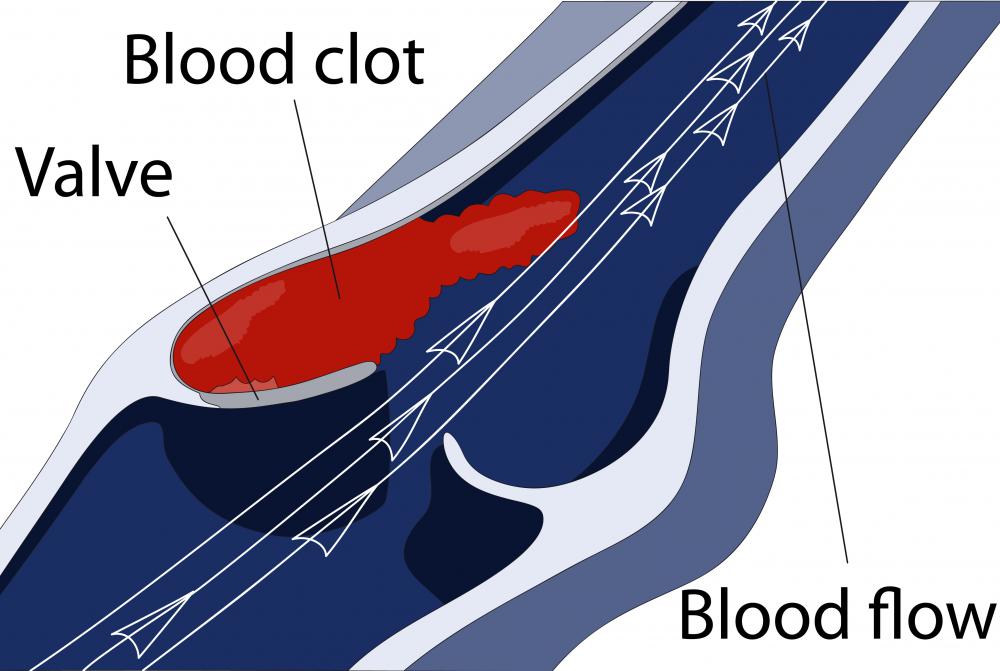At TheHealthBoard, we're committed to delivering accurate, trustworthy information. Our expert-authored content is rigorously fact-checked and sourced from credible authorities. Discover how we uphold the highest standards in providing you with reliable knowledge.
What is Sagittal Sinus Thrombosis?
Sagittal sinus thrombosis, also called a cerebral venous sinus thrombosis, is a rare and potentially fatal type of stroke resulting from a blood clot that obstructs the flow of venous blood away from the brain through one of the intracranial sinuses. Symptoms are similar to the more common conventional stroke, but can be less severe and therefore more difficult to diagnose. Treatment follows the typical course of any blood clot, with some cautionary differences accounting for a sinus’s proximity to the brain.
The cerebral, or dural venous, sinuses are a connected network of channels between the layers of the dura mater, which encase the brain. They receive de-oxygenated blood from both internal and external veins, and the network eventually converges into the sigmoid sinuses. Here, their contents are released into the neck’s internal jugular veins. The inferior sagittal sinus reaches into the brain structure, while the superior sagittal sinus serves a large outer area of the brain. A blood clot that develops within this network is also sometimes called a dural sinus thrombosis.

Blood can clot for many reasons, but are generally categorized according to three fundamental causes: injury to a blood vessel, abnormal blood flow, and hypercoagulability. This last reason, which is defined as the susceptibility of blood to coagulate due to an imbalance in the fluid’s chemicals and components, is frequently the cause of sagittal sinus thrombosis. Any thrombosis should be treated upon detection. Untreated, the condition risks hemorrhage and increase in size. If a blood clot dislodges, it can circulate to a potentially more serious site, such as the heart or lungs.

It is equally important to determine the cause of the blood clot. If there is an underlying pathology such as meningitis, sagittal sinus thrombosis can be recurring. Less common diseases which can cause it include kidney dysfunction, thrombophilia or other blood disorders, and chronic inflammatory diseases such as lupus.
Direct injury to any of the intracranial sinuses can create a thrombus, or blood clot, as can trauma to proximal blood vessels. This can occur during surgeries of the neck or head. Historic studies have shown a proportional increase of sagittal sinus thrombosis in women to 75% of cases. While it had been known that the vascular demands of pregnancy is a risk factor, oral birth contraception containing estrogen is also suspected. If supported with further research, alternate contraceptive methods represent a possible measure for preventing sagittal sinus thrombosis.

Preliminary diagnosis is made through an evaluation of a patient’s stroke-like symptoms, which include paralysis of the limbs, numbness or paralysis of one side of the face, and difficulty with speech. Some 40% of patients will experience seizures, typically affecting just the left or right brain hemisphere, and usually episodic rather than persistent. Most patients will be afflicted with headache; in some cases, this might be the only apparent symptom. The most common age category for sinus thrombosis is the third decade of life; when it occurs outside of this range, the symptoms can be more varied, diffused and difficult to recognize.

When thrombosis is suspected, diagnostic confirmation is usually made with brain imaging technologies. These may include computed tomography (CT), magnetic resonance imaging (MRI), and cerebral angiography. In all three, a short-lived radioactive pharmaceutical is used to make the blood vessels “glow” in vivid detail, but the latter procedure is invasive, requiring a thin catheter to thread through a blood vessel in the leg up to the brain for image acquisition.

Treatment for a sagittal sinus thrombosis usually involves anti-coagulant medication, unless there is concern that the resulting “thinned” blood presents risk of hemorrhaging elsewhere. If ineffective, a more targeted approach to thrombolysis, the breakdown of a thrombus, can be attempted. A stronger anti-coagulant might be prescribed; the blood clot might be addressed at close range with the aid of catheterized angiography. Open brain surgery is rarely contemplated, because the prognosis of treating this dangerous blood clot is statistically quite favorable when performed early. The main complication that a physician will monitor throughout the course of diagnosis, treatment, and recovery will be an alarming rise in intracranial pressure.
AS FEATURED ON:
AS FEATURED ON:



















Discuss this Article
Post your comments